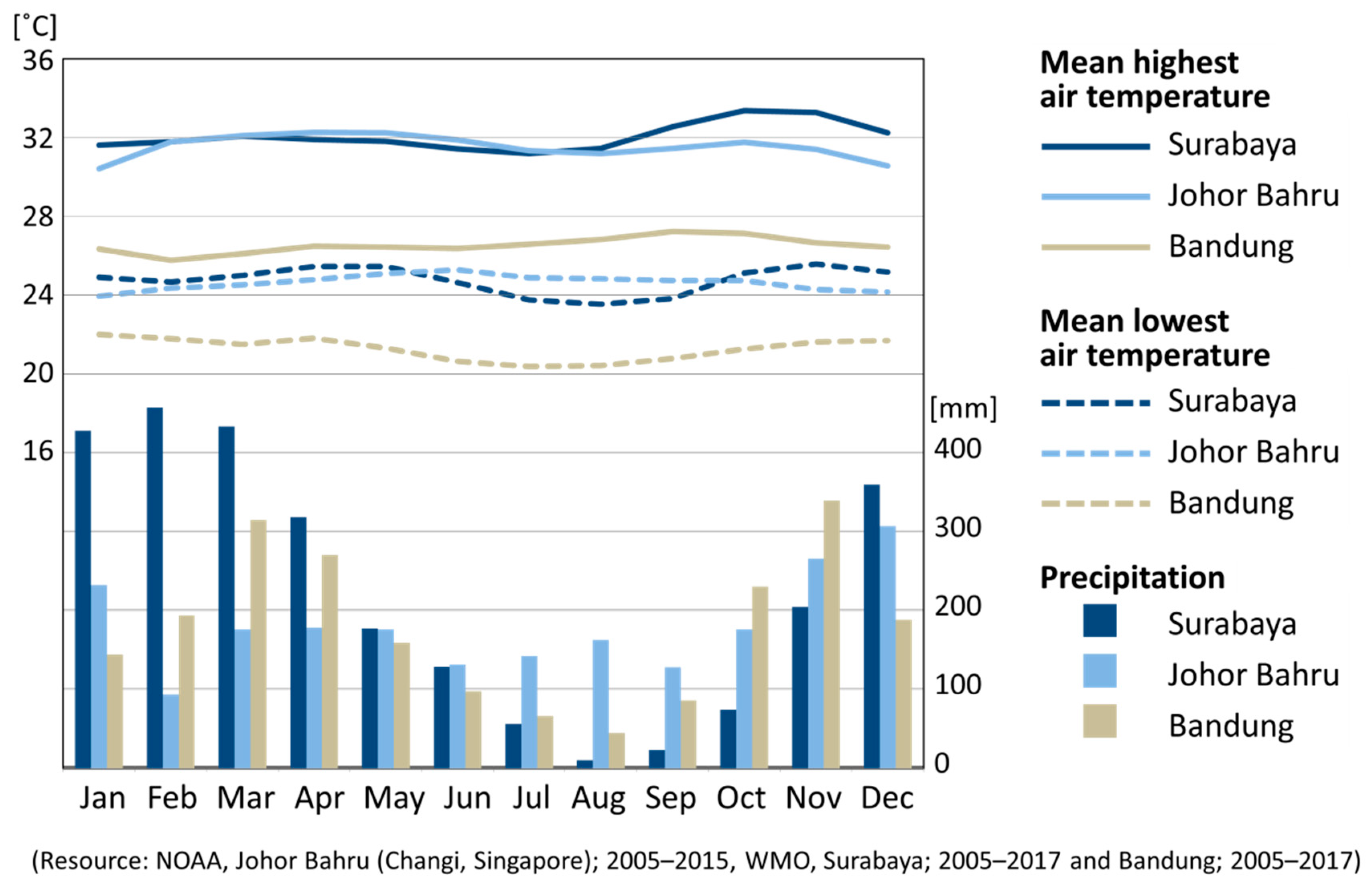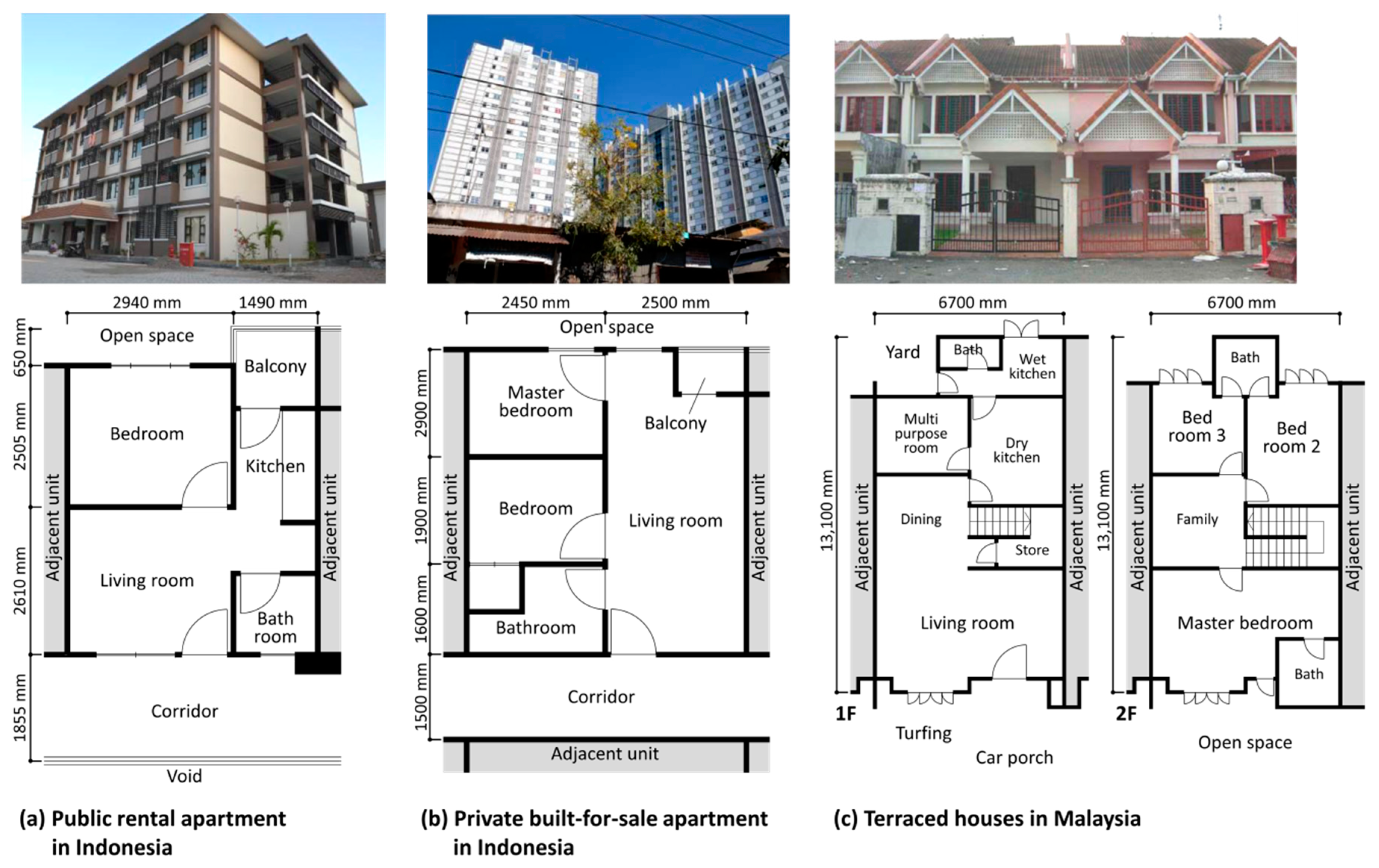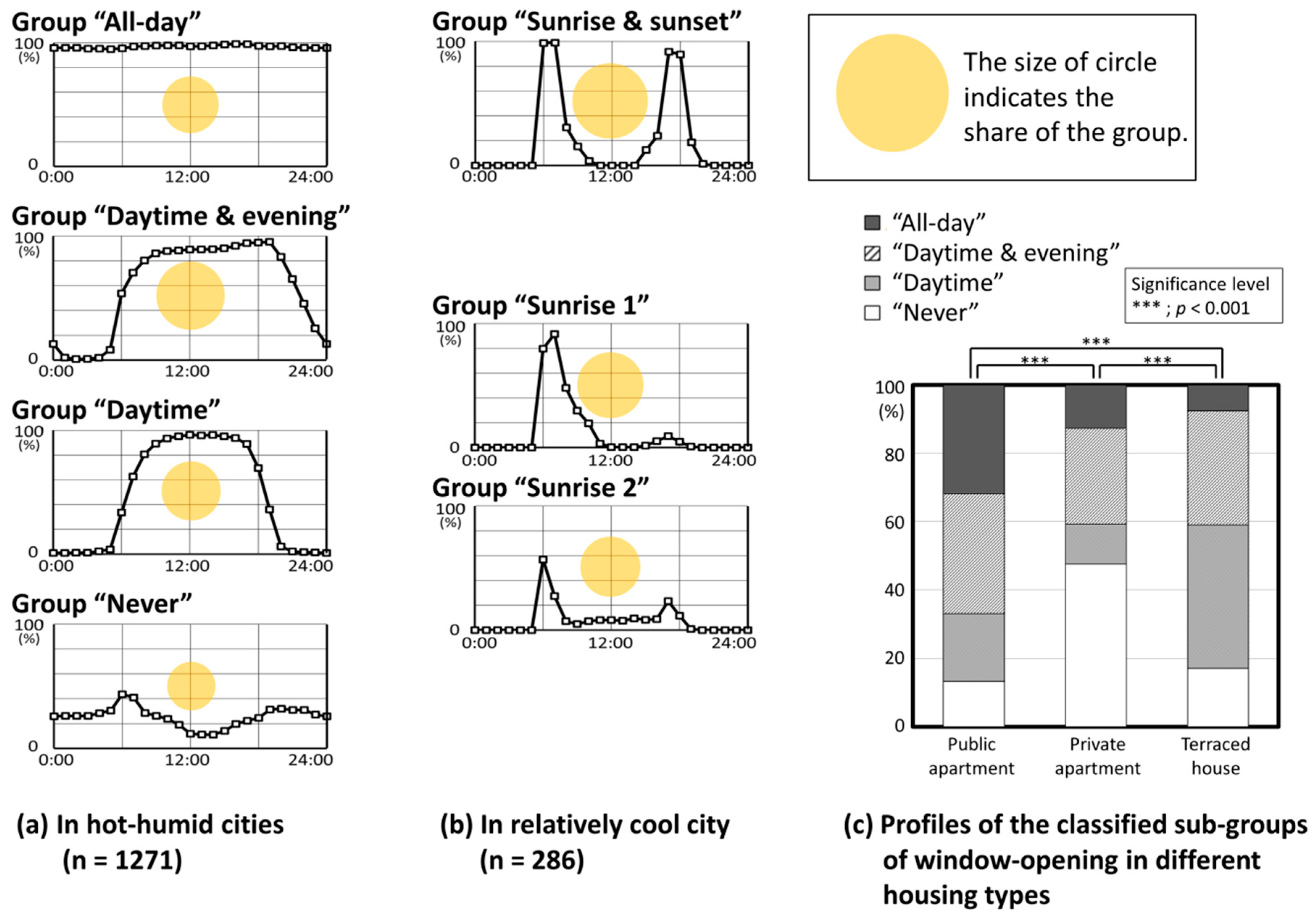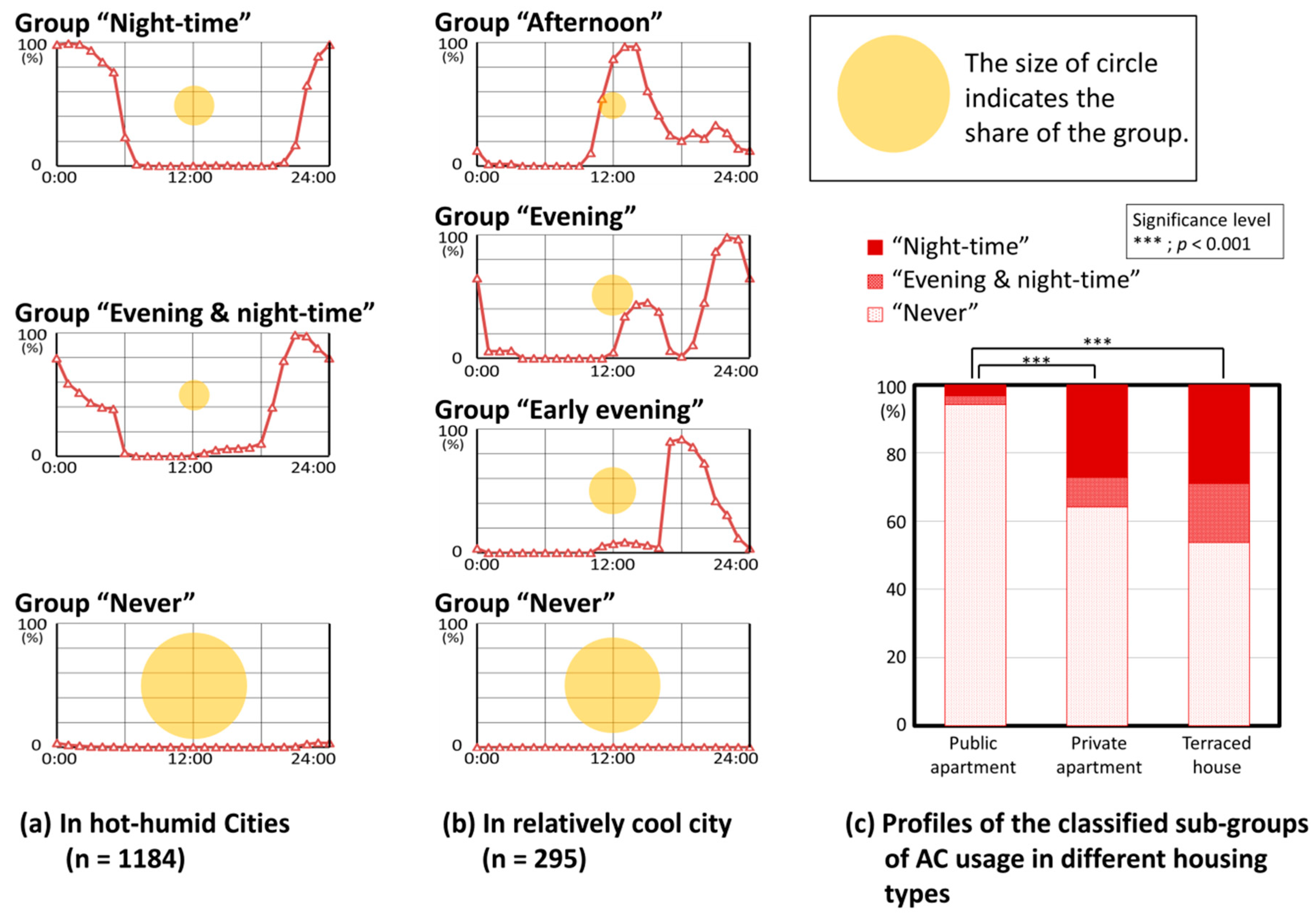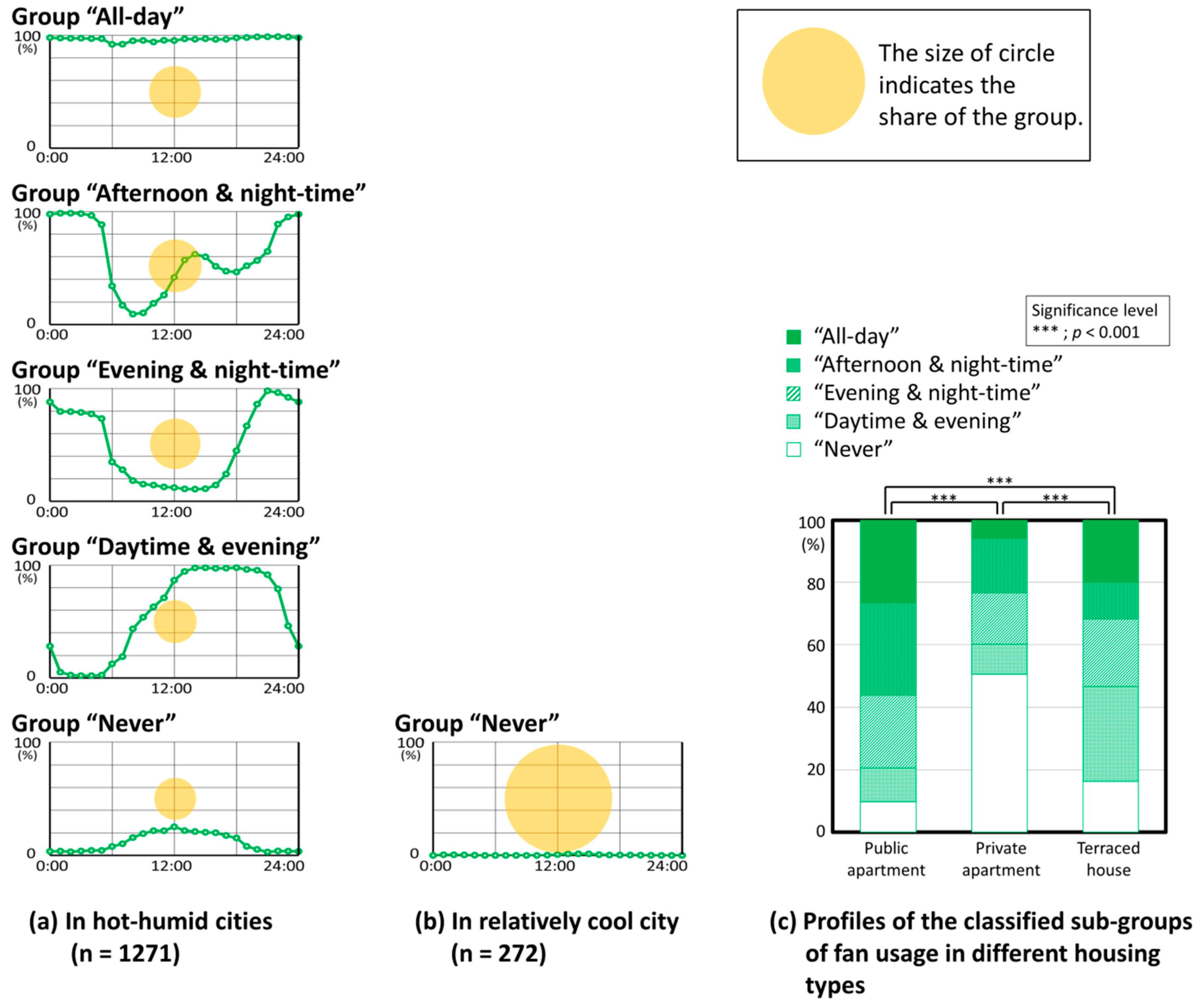1. Introduction
In most cities of Southeast Asia, the daily maximum air temperature often exceeds 30 °C with high humidity of approximately 70–90%. This condition may force occupants to use air conditioners (ACs) to meet their thermal comfort [
1]. Nevertheless, there are concerns that the spread of ACs among urban residential buildings in Southeast Asia will contribute to further increase in primary energy consumption and, therefore, drastically increase CO
2 emissions in the near future [
2]. In general, higher-income households use AC more, and it is expected that the AC ownership rate will increase as household income increases [
3]. In fact, the number of ACs in Southeast Asia is expected to skyrocket from approximately 40 million units in 2018 to 350 million in 2040, mostly for the use in residential buildings. The electricity consumption for cooling in the region is projected to increase from approximately 80 TWh in 2018 to around 330 TWh by 2040 [
2].
Given the need to achieve sustainable societies, passive design, in particular the application of natural ventilation, is considered a feasible strategy for reducing energy consumption for cooling without sacrificing thermal comfort in the hot and humid climates [
4,
5]. Several studies were conducted to determine passive cooling techniques in naturally ventilated buildings to achieve indoor thermal comfort and to reduce the energy consumption for cooling in the hot and humid climates of Asia [
6,
7,
8,
9]. As indoor air temperature can be close to the skin surface temperature with high humidity in the tropics, cooling with comfort ventilation is crucial [
8,
10]. Meanwhile, structural cooling with night ventilation was also found to be effective even in the hot-humid climates in a high thermal mass building [
3,
11]. Hence, it can be seen that window-opening is one of the most important adaptive behaviours affecting indoor thermal comfort as well as household energy consumption in the tropics.
It is important to determine possible factors affecting window-opening behaviour of occupants so that building designers can encourage them to adopt natural ventilation whenever appropriate. Many researchers argued that window-opening behaviour is influenced by various factors that interact in complex ways. For example, Fabi et al. [
12], Schweiker et al. [
13] and Borgeson and Brager [
14] concluded that the possible factors were classified into physical, contextual, psychological, physiological and social factors. Among physical factors, outdoor and indoor air temperature were generally the most influential factors in window-opening behaviour [
15,
16,
17,
18]. Additionally, the indoor CO
2 concentration level was identified as a key factor [
19,
20]. For example, the study by Rijal et al. [
21] in the UK reported that the highest usage of window-opening was found in summer and lowest was in winter. It was concluded that people are likely to open their windows when indoor and outdoor temperatures are high and tend to close them when the temperatures are low [
22]. Similar results were obtained by Rijal et al. [
23,
24] in Gifu and Kanto region of Japan. It was found that the probability of window-opening in naturally ventilated buildings gradually increases toward summer and decreases after summer along with changes in average temperatures. As a result of logistic regression analysis, they showed that window-opening behaviour is predictable based on indoor or outdoor air temperature.
Despite the fact that most previous studies only consider environmental variables as key influential factors of occupants’ interaction with windows [
15,
16,
25,
26,
27,
28,
29], different parameters can influence the control on natural ventilation [
30,
31]. Cali et al. [
32] monitored changes in indoor thermal environment and window-opening behaviour for four years in apartments in Southern Germany. It was found by a logistic regression analysis that the factors affecting window-opening were the time of day and the CO
2 concentration, while those affecting window-closing were the average daily outdoor temperature and the time of day. Stazi et al. [
33] reviewed previous relevant studies on the factors of adaptive behaviour. They also pointed out that window-opening behaviour in residential buildings is influenced by indoor and outdoor air temperatures and CO
2 concentration and is mainly related to occupants’ indoor activities. Andersen [
34] found that some people in Danish dwellings opened their windows for ten minutes every day regardless of air temperatures. This implied that the factors affecting window-opening can be not only thermal conditions but also other factors such as cultural factors or daily routine. Brager et al. [
35] found that there are differences in occupants’ thermal comfort responses between air-conditioned and naturally ventilated buildings. This is partially because the difference in the building context greatly affects occupants’ expectations regarding the thermal environment.
According to Schweiker et al. [
36], the contextual factors included the time of day or arriving/leaving times [
19,
37,
38,
39,
40,
41,
42], the previous control state [
37], geographical location [
43,
44], ventilation type [
37,
44,
45], building system and envelope characteristics [
42,
46], facade orientation [
47], dress code [
48], season or cloud cover, socioeconomics [
49], and occupancy levels [
50]. Particularly, in residential buildings, window interaction habits were found to be not time dependent, but rather activity dependent [
17]. Nevertheless, Jeong et al. [
31] confirmed that occupants’ window opening was time-dependent due to activities such as sleeping, cooking and cleaning. Furthermore, Shi et al. [
51] argued that with regard to residential buildings, different residences would have different window opening behaviours under the same environmental condition. This residence-level variety may be attributed to the household features. However, few studies analysed the effect of household features on the residential window-opening behaviour.
Seasonal changes in thermal conditions are almost absent in most parts of the tropical Southeast Asia, except for the precipitation and wind conditions—for example, the monthly average air temperature varies within 2 °C in Jakarta. Hence, window-opening behaviour of an occupant in this region can be uniform throughout the year. In other words, non-temperature variables, including (1) contextual factors such as time of day and building type, (2) household features as well as personal and social factors, and (3) phycological factors such as personal preference, can be more influential for the window-opening in the tropics, although outdoor and indoor air temperatures were found to be the most influential factors in other regions. Therefore, this study examines occupants’ daily average patterns of window-opening and AC usage without considering the seasonal changes in outdoor weather conditions in the tropical Southeast Asia. The present study assumes that there are more influential factors beyond the outdoor and indoor air temperatures in the case of tropics and aims to determine the contextual factors and household attributes influencing the typical daily patterns of window-opening.
Generally, there are three major approaches of collecting occupant-related data for the purpose of researching building occupants, namely in situ, laboratory and survey [
52]. The in situ studies, which is the most commonly used approach in the previous studies, involve monitoring occupants in their natural environments (e.g., workplace, home, school, etc.) and typically have a long data collection duration (weeks or years) [
52]. However, in contrast to the other approaches, in situ methods often limit the sample size to the number of willing participants in the subject building [
52]. O’Brien et al. [
53] indicated that the sample size is of great importance to monitor occupant diversity in a population. They suggested that hundreds of occupant samples were more appropriate rather than 10 to 15 samples, which were used in most existing studies [
54]. The present study, therefore, adopted large-scale surveys to analyse the above-mentioned personal/household differences in typical window-opening patterns through a data mining approach with a large number of samples (N = 1570). Data mining techniques are powerful methods to extract hidden patterns and knowledge from large datasets and have also been applied to develop occupants’ behaviour models [
55,
56,
57]. Among various data mining techniques, decision tree, Bayesian network, cluster analysis and association rule mining methods are commonly used for prediction and recognition of occupant behaviour patterns. For example, D’Oca and Hong [
40] used a cluster analysis to obtain window opening and closing behaviour patterns based on distinct datasets, and association rule mining was then conducted to discover the frequent patterns that concurrently existed.
Several review papers on occupant behaviour have been published in recent years [
12,
33,
36,
54,
58,
59,
60,
61]. Some of the studies pointed out that there are few studies in the tropical regions. For example, Schweiker et al. [
36] reported that all field studies took place in regions where there are discernible heating and cooling seasons, and no studies were undertaken in the tropics or sub-tropics. Du et al. [
61] also concluded that previous studies have covered most climate zones, but limited data are available for the hot-humid zone. Meanwhile, Kubota et al. [
3] reported through a survey in Malaysia that nearly 80% of the respondents normally opened their windows during daytime from 10 am to 6 pm, but only 10% practiced it at night. According to the results of a study by Arethusa et al. [
62] in Indonesian apartments, similarly, 80–90% of the respondents opened their windows during daytime (6:00 to 19:00) and 30–50% closed at night (19:00–6:00). Regarding AC usage, Uno et al. [
63] reported that most respondents in Indonesia answered that they use ACs from 21:00 to 6:00 during night-time and from 13:00 to 15:00 during daytime. The results of surveys carried out by Ekasiwi et al. [
64] in Indonesia and Malaysia showed that some occupants still open their windows even during the use of ACs. However, the said studies conducted in the tropics only revealed the current average conditions of occupant behaviour and failed to analyse the personal/household differences among samples.
In this study, the large-scale surveys were conducted in major cities of Malaysia and Indonesia during 2004–2016. The main objective of this study is to extract various typical daily patterns of window-opening, AC usage and fan usage among occupants in the tropics through a data mining approach based on a cluster analysis. These behavioural patterns are expected to be diversified to some extent, as they are influenced by other factors than seasonal changes in air temperatures. Furthermore, influential factors for window-opening patterns, focusing especially on contextual factors such as the time of day as well as household attributes, are determined through a logistic regression analysis. The results of this study will fill the existing knowledge gap in driving factors of occupant behaviour in the tropics, and thus provide useful insights for designers to promote natural ventilation for residential buildings. Furthermore, the resultant patterns can be used for thermal simulations and energy simulations as input data representing the occupants’ behaviour.
In this paper,
Section 2 describes the methodology in detail.
Section 3, Results and Discussion, first shows the results of typical daily patterns of window-opening and those of AC usage and fan usage. Second, we discuss the associations among the above-mentioned adaptive behaviours, followed by the reasons for not opening windows.
